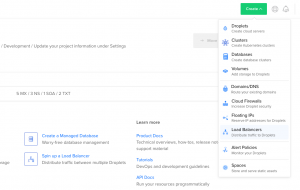What is load balancer? How to setup load balancer in DigitalOcean

Load Balancing manages workload between two or more computers(machines). The advantage of load balancing is that allows for more efficient use of computing resources and prevents anyone machine from being overload. This is very important for high traffic website.
In short, Load balancers manage traffic to groups of Droplets, which decouples the overall health of a backend service from the health of a single server to make sure that your services stay online. [1]
There are two steps for creating load balancing.
- 1. Creating a load balancer.
- 2. choosing droplet for its backend.
1. Create Load Balancers
Step 1: Start by creating a load balancer using the Create button at the top of the control panel.

On the creation page, you will:
Step 2: Choose a datacenter region. Your load balancer and its backend Droplets need to be in the same datacenter, so choose the region where your Droplets are or will be located.
Step 3: Add forwarding rules. Forwarding rules define how traffic is routed from the load balancer to its backend Droplets. You need at least one rule.
The default route is HTTP port 80 on the load balancer to HTTP port 80 on the backend Droplets. If you want you can create new rules during creation with the New Rule drop-down. After creation, you can modify a load balancer’s rules at any time on its Settings page.
Step 4: Finalize and create, which includes Choose a name and Select project. Load balancer names must be unique and contain alphanumeric characters, dashes, and periods only.
Video of Create LoadBalancer and setup up Droplet.
2. Select Droplets
After you create the load balancer, you’ll be brought to the load balancer’s detail page where you can add Droplets to it. Click Choose Droplets to open the Add Droplets window.
You can add individual Droplets or you can choose a tag. You can only choose Droplets that are in the same region as the load balancer.
When you’ve selected the tag or Droplets, click Add Droplets. The load balancer will check the health of the backend Droplets. Once the servers have passed the health check the required number of times, they will be marked healthy and the load balancer will begin forwarding requests to them.
Once you have at least one load balancer, you can view and manage them on the load balancer index page.
3. Load Balancing Algorithms
The load balancing algorithms provide different advantages; the choice of load balancing method depends on your needs:
Round Robin – Requests from clients are spread out across the group of servers sequentially.
Least Connections – A new request from the client is sent to the server with the fewest current connections to clients. [2]
Conclusion
So we can say that load balancer is a very useful utility for large scale projects for handling sudden hike of incoming requests. And digital ocean provide this useful utility in very few steps and in hassle less manner.
Arkay Apps is DigitalOcean cloud partner we provide cloud server maintenance server let save your time we all manage on server maintenance. let’s arrange meeting with our expert.
Reference
- https://www.digitalocean.com/docs/networking/load-balancers/
- https://www.digitalocean.com/docs/networking/load-balancers/how-to/create/

